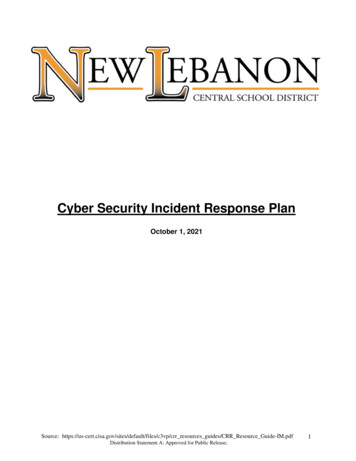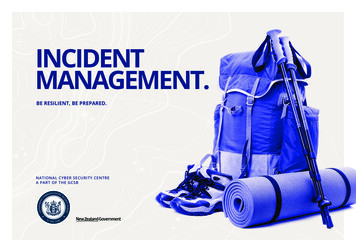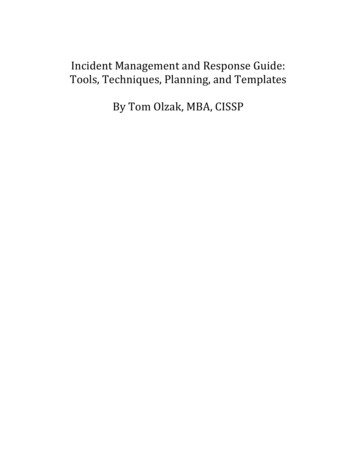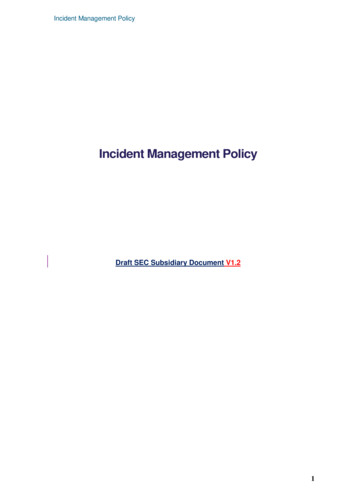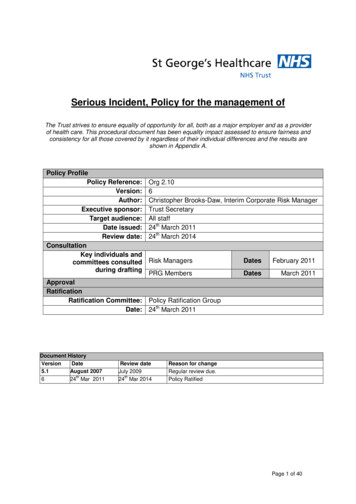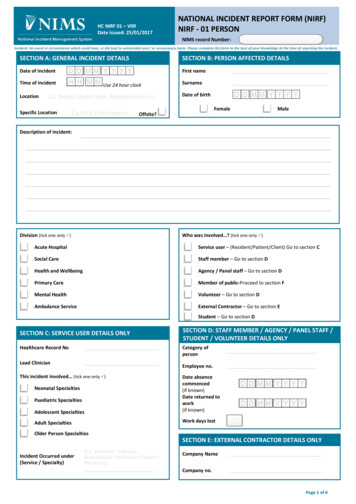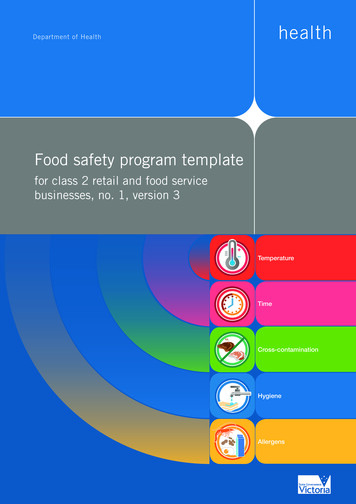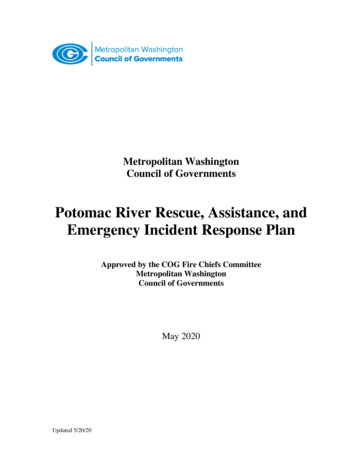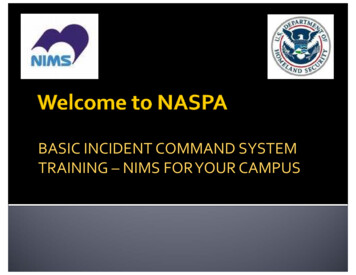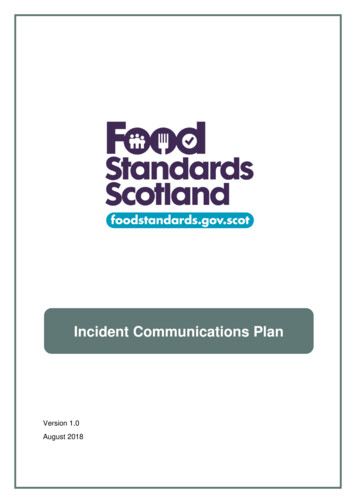
Transcription
Incident Communications PlanVersion 1.0August 2018
Version ControlVersion1.0DateAugust 2018Last reviewcarried outN/ANext review dueFebruary 2019Contents1.2.3.4.IntroductionIncident Communications PrinciplesScopeComms Roles and Responsibilities in an Incident4.1 Response Structure4.2 Incident Assessment Team4.3 Operational Incident Team4.4 Strategic Incident Team4.5 Incident Communications Handling Strategy4.6 Communications Team4.7 Media and Social Media Policies5. Incident Response5.1 Initial Response5.2 Summary of Communications Response5.3 Clearances5.4 FSA-led Communications5.5 IMT-led Communications6. Contacts and On Call7. Key Spokespeople7.1 Board and Executive Spokespeople7.2 Role of the Board8. Stakeholder Management8.1 Stakeholder Management Process8.2 Stakeholder Engagement Matrix8.3 Key Organisation Checklist8.4 Stakeholder List9. Internal Communications10. Post-Incident and Ex-Incident ActionsGlossaryANNEXA TemplatesB Media HandlingC SpokespeopleD Social 324252627-3637-4244-4748-49CommentsFirst version
1. IntroductionFood Standards Scotland’s Incident Communications Plan aims to provide an overarching strategyand guiding principles to the organisation when it comes to communicating with the public andinternal and external stakeholders during non-routine incidents. It is also designed as a workingmanual for the Communications team, with templates and tools to be used during an incident, for aconsistent and agreed approach, and to ensure FSS responds to incidents early, proportionatelyand in terms that are accessible to the public.A non-routine incident is defined as a serious (Level 2), severe (Level 3) or major (Level 4) incidentwhich cannot be managed under business as usual terms, under standard operating procedures,and which requires direct senior leadership involvement.The ICP is written primarily as a manual for the FSS Communications team, and a version,excluding personal data, is available on our website. It is not designed as a communications 101document, as it assumes knowledge of business-as-usual media relations practices andprocedures.The ICP takes a recognised approach used in food and feed-related incidents and public healthresponses across the globe which combines crisis communication and risk communication. Thisapproach is designed to help people make sound decisions to protect themselves and theirfamilies, often in circumstances where FSS is operating with limited time and limited information,and often with a high degree of uncertainty. Communications during an incident must take intoaccount both the level of uncertainty at any given time as well as the degree of precaution beingapplied, to manage firstly the risk in terms of public health, and also the potential for reputationaldamage, whilst also recognising the impact communications may have on an implicated business.It should be understood that the higher the levels of uncertainty, the greater the degree ofprecaution being applied.It is important to remember during and outwith an incident that managing FSS’s reputation is theresponsibility of everyone within FSS through all our actions and interactions. It should also benoted that there is a key role for all those involved in an incident when it comes to communicatingwith stakeholders. This is clarified in this document, as are the channels and means by which weshould engage with our own staff and Board, the Food Standards Agency, SG and Ministers andof course, the Scottish public, whilst also bearing in mind the implications for business and,potentially, the wider food industry.Katherine GoodwinHead of Communications and Marketingkatherine.goodwin@fss.scot3
2. Incident Communications PrinciplesFSS’s primary strategic aim is protecting public health, and decisions around communications arealways taken in the best interests of consumers. As a secondary consideration, the potential forreputational risk: to FSS, to an implicated business and to the wider industry and economy, shouldalso be assessed and monitored during an incident. FSS has a low tolerance level for reputationalrisk during non-routine incidents, given the consequent impact this could have in terms of FSS’scredibility in any existing and subsequent incidents. However, where any confusion or ambiguityarises from media coverage which is inaccurate or negative towards FSS where public health is atrisk, that tolerance level will lower.During a non-routine incident, FSS communications will abide by certain core principles:Be early – we will aim to give out information as early as possible during an incident, and will –subject to any legal restrictions - release information as and when relevant throughout. It is criticalthat FSS aims to set the media agenda and dampen speculation, and shows leadership externallyand internally as soon as possible.Be on the public’s side – decisions as to what information to give out, and when, will be based,predominantly on what consumers should know in order to protect public health: consumers’interests are paramount above political or business interests.Be evidence-based - FSS also has a strategic objective of supporting responsible foodbusinesses, so all decisions regarding external communications which could impact a businessand individuals’ livelihoods will be evidence-based and proportionate.Be accurate – the information we give should be correct and based on the latest availableevidence. Accuracy is critical to credibility, but does not necessarily mean detail, and we can andshould communicate when there is still uncertainty.Be human – we should present a human face and empathetic leadership to the public –particularly in providing spokespeople to the media.Be clear – we will communicate in plain English, without ‘blinding people with science’ or beingoverly formal, stilted, detailed or technical. We will be concise and to the point, and will not cloudmeaning with corporate jargon or the language of policy.Be transparent – we will always be truthful and transparent, and open about the level ofuncertainty and risk in an emerging incident. We will also be honest when we cannot divulgeinformation and give the reasons: for example, because it may jeopardise a future prosecution, orbreach confidentiality.Be purposeful – outline what actions people can take to protect themselves and help us remedythe problem.4
Be broad-shouldered - FSS accepts that the organisation may face negative media commentaryduring a non-routine incident as a public sector body and regulator: the FSS Communicationsteam will address inaccuracy amongst media coverage but as a general principle, the organisationwill not enter into a public debate about any criticism, unless that criticism could prove detrimentalto public trust in FSS and a consequent risk to public health, should our advice be undermined ordisregarded.5
3. ScopeDuring a food incident, the public must know where to turn for authoritative information and advice.Building authority, credibility and awareness amongst the public and stakeholders, andstrengthening relationships with the media, is critical for enabling effective communications duringan incident. It’s also vital for FSS to retain authority following an incident, so that we are trustedand believed next time round. This ICP therefore not only focuses on our approach and actionsduring an incident but also post-incident reputation management and actions FSS should takeoutwith an incident. This ICP supports the overarching FSS Incident Management Frameworkwhich outlines how we co-ordinate and manage FSS’s incident response.This plan is designed to cover communications where FSS is in the lead. It should be notedthat separate arrangements are in place for investigations where FSS is not the leadagency, but is a core member of a multi-agency Incident Management Team (IMT)established to investigate an outbreak of illness which could be food-related.However, it is important to consider the other potential scenarios which may impact FSS’s ability tocommunicate. The variables that the FSS Incident Assessment Team will consider at the outset ofa food incident, and which could change as the situation develops, are:PUBLIC HEALTH IMPACT If there is an outbreak of illness where food is suspected to be the source, an Incident ManagementTeam (IMT) will be convened and will give a multi-agency comms responseFSS comms lead if there is no outbreak, and therefore no IMT, but there is a potential public health riskLOCATION & DISTRIBUTION If the incident is UK-wide, FSA comms will lead with FSS involvementIf Scotland only, FSS comms will leadIf food is distributed across the UK from Scotland, the FSA will be involved but FSS comms leadIf distribution is confined to Scotland, FSS comms leadIf the incident extends beyond the UK where FSS is in the lead, counterparts in relevant countries maybe involved If there is a risk to public health, a comms approach should be adopted designed to minimise andmitigate that risk and FSS will leadIf no public health risk, the FSS comms approach remains to act in consumers’ interestsIn the event where there may be future criminal charges brought, it is important that comms does notjeopardise that, whilst retaining the guiding principles of transparency and of acting in the public’s bestinterestsFor any criminal investigations, any media response will be developed in consultation with the SeniorInvestigation Officer (SIO)FOOD SAFETY V FOOD FRAUD 6
4. Communications Roles and Responsibilities in an Incident4.1 Response StructureFSS’s Incident Management Framework outlines in detail how FSS classifies and responds toincidents, and the overall structures, roles and responsibilities.Each of FSS’s incident management teams detailed below will have representation from FSSCommunications.FSS’s Incidents team will initially classify an incident, and will convene an Incident AssessmentTeam (IAT) should the level and severity of the incident be unclear and evolving.4.2 Incident Assessment Team (IAT)The Communications representative (usually the Senior Communications Manager) will attend theIAT in a core role to agree on the classification of the incident.The Comms role on an IAT is to provide communications expertise and advice, including a view onreputational risk. The IAT will identify the situation and consider the potential threat to publicsafety, FSS’s operations and reputation. The Incidents Team or IAT will classify the incident as perthe following:7
4.3 Operational Incident Team (OIT)The OIT will be the sole incident management team in a Level 2 incident. The OITCommunications Manager role will be fulfilled by either the Senior Communications Manager orCommunications Manager, who will attend the Operational Incident Team meetings in a core role.OIT CHECKLIST FOR COMMUNICATIONS MANAGER:Role: Communications ManagerResponsible for: Overseeing all aspects of FSS’s communication response,including the development of messaging, communication materials and coordinating the stakeholder engagement matrix. This role should be fulfilled by theSenior Communications Manager or Communications Manager.ResponsibilitiesAttend all OIT meetings as a core memberWhere necessary, ensure FSS’s PR agency has been informedProvide updates to the OIT on incident communications during OIT meetings(in the format of Issues and Actions to aide information capture)Consider the wider risk assessment throughout the incident: report on anypotential impacts on FSS’s reputation, taking into account the media, public,government and other stakeholdersDuring a Level 2 incident, develop the communications handling strategy,taking into consideration all stakeholder groups for approval by OIT ChairPopulate the stakeholder engagement matrix and assign owners during OITmeetings. Ensure this is reviewed at each OIT meetingProduce key messages for approval by the OIT Chair and co-ordinatedevelopment of additional external communications to be issued in agreementwith the OIT ChairProduce internal communication materials, as requiredCo-ordinate stakeholder engagement and ensure communications are takingplace across the OIT as necessarySupport the development of ministerial briefings, as requiredCo-ordinate development of the Q&ARe-assess pre-developed communication materials for the incident8 /X
4.4 Strategic Incident Team (SIT)The Strategic Incident Team (SIT) will be established in Level 3 and 4 incidents, and will set thestrategic direction for the management of the incident. The OIT will perform an operational roletaking its lead from the SIT and implementing the actions required that are within its remit, as setout in greater detail in FSS’s Incident Management Framework.The Head of Communications and Marketing will attend the SIT meetings in a core role asCommunications Director to provide strategic direction and advice in relation to communications.The Senior Communications Manager will deputise in case of absence.The key role for Communications on the SIT is to agree the communications strategy andcoordinate sign off of key messages and identify strategic stakeholders and develop a stakeholderengagement strategy.SIT CHECKLIST FOR DIRECTOR OF COMMUNICATIONS:Role: Communications DirectorResponsible for: Representing the Communications team on the SIT and fordeveloping the communications strategy in Level 3 & 4 incidents. This role will befulfilled by the Head of Communications (or nominated deputy).ResponsibilitiesAttend all SIT meetings as a core memberProvide updates to the SIT during SIT meetings ( in the format of Issues andActions to aide Information capture)Provide communications expertise to support the SIT Chair to sign off keyFSS messages and external statements in Level 3/ 4 incidentsWhere necessary, ensure PR agency has been informedReport on any potential issues, impacts on FSS’s reputation, taking intoaccount the media, public, government and other stakeholdersDevelop the communications strategy taking into consideration allstakeholder groupsEnsure that the OIT has sufficient communications resource to manage theresponseOversee stakeholder engagement and ensure communications are takingplace as necessaryWhere relevant, support the development of ministerial briefings9
4.5Incident Communications Handling StrategyIn a Level 2 incident, the OIT Communications Manager should draft a handling strategy, includingtiming of communications and key messages, and agree those with the OIT Chair, before briefingthe rest of the FSS communications team to implement the strategy, using the key messages asthe basis for individual communications elements.During a Level 3 or 4 incident, this role will be taken on by the SIT Communications Director andagreed with the SIT Chair. The SIT Communications Director will then brief the OITCommunications Manager who will implement with the wider communications team.See Annex A1 for template SIT Handling Strategy and A2 for Key Message developmentguidance.4.6Communications TeamThe core Incident Communications Team (SIT Comms Director and OIT Comms Manager)operates with support from others within the Communications and Marketing Branch, particularlythe on call press office team. These roles are not specific to an incident, but will be called uponfrom within the existing branch structure to support the incident response as required:Head ofCommunications andMarketingDigital MarketingManagerSenior CommunicationsManagerON CALL ROTAPRESS OFFICESTAKEHOLDERENGAGEMENTPRESS OFFICEDIGITAL COMMSPUBLICATIONSComms & MarketingExecutiveSTAKEHOLDER COMMSWEBSITE UPDATESSOCIAL MEDIA10Marketing ManagerEMAIL AND TEXTALERTSCommunicationsManagerON CALL icationsExecutiveON CALL ROTAON CALL ROTAPRESS OFFICEPRESS OFFICEINTERNAL COMMSSOCIAL MEDIAADVERTISING
The Senior Communications Manager, Communications Manager and two CommunicationsExecutives rotate being on call to deal with media enquiries. However, should the CommunicationsExecutives be the on call comms contact during a Level 2-4 incident, they will contact the OITCommunications Manager or SIT Communications Director for support and advice for assistancewith out of hours enquiries that cannot be dealt with through existing lines or Q&A. During officehours, in a Level 3 or 4, all incident-related media calls should be directed to the OITCommunications Manager. In a Level 2, the OIT Communications Manager should be alerted tomedia enquiries and their advice sought regarding the response.The team will also be responsible for social media and media monitoring, including developmentand agreement of keywords with the OIT Communications Manager.Website updates, digital communications, assistance with email and text alerts and support withstakeholder comms will be handled by the Digital Marketing Manager and Comms & MarketingExecutive.Should rapid public information broadcast advertising (eg radio ads) be required in a level 3/4, theSIT Communications Director should be contacted and may call upon the Marketing Managerand/or external advertising and media buying agencies for support.NB FSS’s PR Agency is 3X1 PR, the Advertising Agency is the Union, Digital Services (for theFSS website) is Whitespace and Media Buying is carried out by Republic of Media.4.7Media and Social Media PoliciesIn line with our media policy, all media requests should be immediately directed to the FSS pressoffice on 07776 226856. Only designated members of staff and Board members agreed with theChair are permitted to speak to the media or provide comment.Likewise, in line with our social media policy (see Annex D1), only designated members of thesocial media team are permitted to post comments, and only official incident-related tweets andposts from the official FSS account should be shared by FSS staff, Board and senior management.11
5. Incident Response5.1 Initial ResponseIt is important to get information out early to build public trust – this should always be accurate butdoes not have to be detailed. The detail can come when it’s available and as appropriate, as longas we are transparent about the level of uncertainty we are operating under. So it is perfectlyacceptable to go out with an early social media communication (usually a tweet) whichacknowledges there is an emerging issue, and that we will post more detailed information as soonas we have it. There is a balance to be struck between risk communication (and we may not knowat the start of an incident with gaps in available evidence what the level of risk is) and crisiscommunication, where early communication from the authorities is critical to engendering publictrust and for people to know where to turn for advice and information.A tweet should be issued as early as possible: this may well be before the situation becomes clear,and our rapid response tweet should take account of both the uncertainty of the situation and therisk to public health.In Level 2 incidents the OIT Communications Manager will consider the following risk/uncertaintysocial media messaging grid when developing an initial proactive holding social mediacommunication in response to an emerging food incident.In Level 3-4, this will be the role of the SIT Communications Director.Agreement over timing and clearance of the tweet will rest with the OIT Director in a Level 2, andthe SIT Director in Level 3-4.A record of the Communications recommendation and subsequent decision taken by the OIT orSIT should be kept in the OIT or SIT meeting minutes.All tweets and posts should be accompanied by a graphic or image as this gives greater standout,will ensure more people’s eyes are on it and will make it immediately clear what we are referringto. Templates for food alerts and statements can be obtained from the comms team. Examples:12
RISKThe wording in this grid is given as an example, and should be adapted depending on the natureof the incident. It should not be used as a template as each incident is different, and should only bereferred to as a guide:We are currently assessing theinformation coming into us about apossible food incident as a matter ofurgency and will issue moreinformation as soon as possible.[Please contact your GP or NHS 24should you be concerned aboutpossible food poisoning. [link ns/infections-andpoisoning/food-poisoning]]We are currently acting on theinformation we have about a possibleoutbreak of [pathogen] which may belinked to [product name].Investigations are ongoing and thesituation may change, but at this time,we would advise people not to[eat/drink] this product as aprecaution. [Please contact your GP orNHS 24 should you be concernedabout possible food poisoning. [link ns/infections-andpoisoning/food-poisoning]]We are letting the public know aboutan outbreak of [pathogen] linked to[product name] and are advisingpeople not to [eat/drink] this productfor the time being. We will issue moreinformation as soon as possible.[Please contact your GP or NHS 24should you be concerned aboutpossible food poisoning. [link ns/infections-andpoisoning/food-poisoning]]We will keep you updated as soon aswe have more information on thesituation we are investigatingregarding a possible [outbreak of foodpoisoning / food incident]. [Pleaserefer to NHS advice should you beconcerned about possible foodpoisoning: link ns/infections-andpoisoning/food-poisoning]We are currently acting on theinformation we have about a possibleoutbreak of food poisoning which maybe linked to [product name].Investigations are ongoing and thesituation may change but [please referto NHS advice should you beconcerned about possible foodpoisoning: link ns/infections-andpoisoning/food-poisoning]We are aware of a potential publichealth issue relating to [product name]and are currently working with thecompany to investigate further. We willissue more information as soon aspossible. [Please refer to NHS adviceshould you be concerned aboutpossible food poisoning: link ns/infections-andpoisoning/food-poisoning]WAITWe are currently assessing theinformation we have about a possiblefood incident. There appears to belittle risk to public health, but shouldthat situation change, we will issuemore information.We are aware of an issue relating to[category name ie no need to nameproduct at this stage]. There appearsto be little risk to public health, butshould that situation change, we willissue more information.CERTAINTY13
Twitter is the primary social media channel during an incident and others eg Facebook andInstagram, should be treated as secondary channels. The OIT Communications Manager in aLevel 2, or the SIT Communications Director in Level 3 or 4, will decide which social mediachannels should be used, as it may be that, depending on the nature of the incident, thosesecondary channels may not be appropriate channels to relay news about a serious incident. Allsocial media channels will be monitored as a listening tool.14
5.2Summary of Communications ResponseLevel 4:Major incidentLevel 3:Severe IncidentLevel 2:Serious IncidentLevel 1:Routine incidentThe following gives a snapshot of the key actions to be undertaken, depending on the severity ofthe incident:15Business as usual responseCommunicate to public via social media channelsPossible webstory link to product recall information notice (PRIN),Allergy Allert (AA) or Food Alert (FAFA)Early holding tweetPress release/statementWebstory linked to PRIN or food alert (FAFA)Social media channelsConsider need for spokespersonConsider background media briefingSocial media listeningMedia monitoringInternal communications via existing channelsEarly holding tweetPress release/statementWebstory linked to PRIN/FAFASocial media channelsSIT Representative/Chair or Vice Chair available for interviewBackground media briefingConsideration of press conferenceSocial media listeningMedia monitoringInternal communications via email from CEOEarly holding tweet / statement OR retweet SGORR tweets/statementsPress release/statement webstory OR input into SGORR commsSocial media channels OR input into SGORR commsCEO/Chair available for interview alongside Government MinisterBackground media briefingPress conference alongside Government MinisterInternal communications via email from CEO
5.3ClearancesLevel 4:Major incidentLevel 3:Severe IncidentLevel 2:Serious IncidentLevel 1:Routine incidentThe over-riding principle when it comes to obtaining clearance needs to be of responding swiftlyand decisively, so all those involved in clearing communications materials should be fully aware ofand adhere to the FSS Communications Guiding Principles (p4), and in particular the aims to ‘BeEarly’ and to ‘Be Clear’. Clearances of lines, press releases, statements etc should be soughtdepending on the level of the incident.16Business as usual clearances should be sought as per Comms team StandardOperating Procedures.The OIT Communications Manager will outline the communications options fordiscussion by the OIT and once the communications approach is agreed, theOIT Comms Manager will then draft the communications handling strategy andkey messages/lines to take, upon which all other communications materials willbe based. The final decision regarding the operational communicationsapproach rests with the OIT Chair and he/she will sign the CommunicationsHandling Strategy.The SIT Communications Director will outline the communications options fordiscussion by the SIT and once the communications approach is agreed, theSIT Comms Director will then draft the communications handling strategy andkey messages/lines to take, upon which all other communications materials willbe based. In Level 3, the SIT Chair clears the communications handlingstrategy, whilst responsibility for operational communications remains with theOIT Chair. The final decision regarding the overall incident communicationsapproach rests with the SIT Chair and he/she will sign the CommunicationsHandling Strategy.In Level 4, clearances are as per Level 3, with clearances sought from SG asappropriate, in line with SG ‘Preparing Scotland’ guidance. The FSS SITComms Director and OIT Comms Manager must establish lines ofcommunication with SGoRR early on and have frequent contact with theSGoRR Comms leads.
5.4FSA-led Incident CommunicationsDuring an FSA-led incident, FSS will issue communications in Scotland as agreed and cleared byFSS and the FSA’s SIOG (the FSA equivalent of the SIT). Joint releases should include referenceto FSS, and any statements from Chief Executives and/or Chairs should be joint between the FSSand FSA. Joint communications materials should also be jointly branded.5.5IMT-led CommunicationsDuring an outbreak of foodborne illness where the investigation is led by a multi-agency IMT, FSSwill look to issue public advice if it is deemed necessary to act to protect public health. Even wherethere are high levels of uncertainty, FSS will ensure communications focus on the actions beingtaken to protect public health. FSS will engage with the media to ensure that they and the publichave a fuller picture of what is happening. It is important that a communications vacuum is notcreated by saying nothing as this may lead to misinformation or misrepresentation.Clearances must be sought for all communications from the IMT. In the event of an outbreak offoodborne illness and the establishment of an IMT, media lines and communications will be agreedas per the IMT agreed protocols, with FSS taking the lead in terms of providing food safetyinformation and advice to consumers.17
6. Contacts and On CallKey comms contacts at the start of and during an incident are:Katherine GoodwinHead of Communications and MarketingMaria TocherSenior Communications Managerpressoffice@fss.scot01224 2851006.1 Communications On-Call RotaFSS Communications On Call (24 hours) 07776 226856Four press office team members rotate the comms on call rota on a weekly basis.The Head of Comms and Marketing is not on this rota, but is available to the OIT, SIT, Commsteam and SMT on 07780 227431.Our PR agency, 3X1 are also available out of hours on 07736 176 597, or during office hours:18
6.2 Additional ContactsSG Press Office (out of hours) 0300 244 4000FSA Press Office (out of hours) 07507 309584 (text)FSS Incidents Team 07881 516867FSA Incidents Team 0207 276 8448ChairRoss FinnieSenior Management TeamGeoff OgleElspeth MacdonaldIan McWattGarry MournianOther FSS AgenciesThe Union Advertising Agency 0131 625 6000Republic of Media 0131 230 0110Whitespace 0131 625 550019
7. Key Spokespeople7.1Board and Executive SpokespeopleIt is important that FSS presents a human face during a food incident, to convey information andreassure the public. Our key spokespeople are:Ross Finnie – ChairLouise Welsh – Vice-ChairGeoff Ogle – CEOElspeth Macdonald - DCEOIan McWatt – Director of OperationsRon McNaughton – Head of the Scottish Food Crime & Incidents UnitNorval Strachan – Chief Scientific AdviserJacqui McElhiney – Head of Food Safety and SurveillanceHeather Peace – Head of NutritionIt is the role of the Communications Director in the SIT working with the Communications Managerin the OIT to identify and recommend the most appropriate spokesperson for the incident.Should the relevant policy lead be identified as the key spokesperson, but not be available, in aLevel 2, it may be agreed that their designated deputy should become the key mediaspokesperson.However, in a Level 3 or 4 incident, delegation should be up the way in terms of seniority. It willgenerally be most appropriate for Ross Finnie and/or Geoff Ogle, o
Be purposeful - outline what actions people can take to protect themselves and help us remedy the problem. 5. . If there is an outbreak of illness where food is suspected to be the source, an Incident Management Team (IMT) will be convenedand will give a multi-agency comms response FSS comms lead if there is no outbreak, and .
